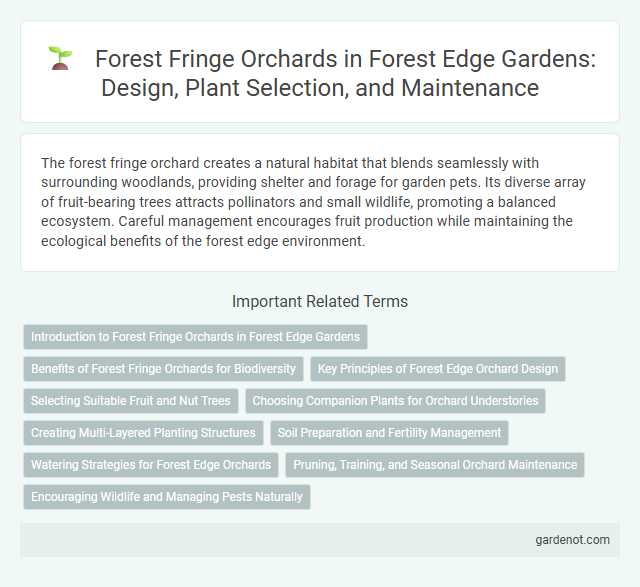The forest fringe orchard creates a natural habitat that blends seamlessly with surrounding woodlands, providing shelter and forage for garden pets. Its diverse array of fruit-bearing trees attracts pollinators and small wildlife, promoting a balanced ecosystem. Careful management encourages fruit production while maintaining the ecological benefits of the forest edge environment.
Introduction to Forest Fringe Orchards in Forest Edge Gardens
Forest fringe orchards enhance forest edge gardens by integrating diverse fruit and nut trees that thrive in transitional zones between dense woods and open spaces. These orchards support biodiversity, improve soil health through deep-rooted species, and create microhabitats beneficial for pollinators and wildlife. Incorporating native and adapted fruit tree varieties maximizes resilience and productivity in forest-edge ecosystems.
Benefits of Forest Fringe Orchards for Biodiversity
Forest fringe orchards create diverse habitats that support a wide range of wildlife, including pollinators, birds, and small mammals, enhancing local biodiversity. These orchards serve as ecological buffers between dense forests and open landscapes, promoting species migration and genetic exchange. The variety of native trees and shrubs in forest fringe orchards improves soil health and microclimates, contributing to ecosystem resilience.
Key Principles of Forest Edge Orchard Design
Forest fringe orchard design emphasizes biodiversity, integrating fruit trees with native woodland species to create a resilient ecosystem. Key principles include layering vegetation to maximize sunlight capture, enhancing soil health through natural mulching and composting, and promoting habitat connectivity for beneficial wildlife. Strategic spacing and species selection ensure sustained productivity while maintaining the ecological balance of the forest edge.
Selecting Suitable Fruit and Nut Trees
Choosing fruit and nut trees for a forest fringe orchard requires assessing soil quality, sunlight availability, and local climate conditions to ensure optimal growth and yield. Hardy varieties such as hazelnut, pawpaw, crabapple, and serviceberry thrive at forest edges, benefiting from partial shade and wind protection. Integrating native species not only supports biodiversity but also enhances resilience against pests and diseases, creating a sustainable orchard ecosystem.
Choosing Companion Plants for Orchard Understories
Selecting companion plants for orchard understories in forest fringe gardens enhances biodiversity and boosts fruit tree health. Shade-tolerant species like wild ginger, comfrey, and ferns improve soil quality, retain moisture, and attract beneficial pollinators and predators. Integrating nitrogen-fixing plants such as clover or vetch supports nutrient cycling and strengthens orchard resilience in forest edge environments.
Creating Multi-Layered Planting Structures
Forest fringe orchards enhance biodiversity and productivity by utilizing multi-layered planting structures that mimic natural forest edges. Combining canopy trees, understory shrubs, and ground cover plants creates vertical diversity that optimizes light capture and nutrient cycling. This stratification supports diverse wildlife habitats and improves soil health through natural mulch and nitrogen fixation.
Soil Preparation and Fertility Management
Forest fringe orchards thrive when soil preparation emphasizes deep tilling to improve aeration and root penetration, combined with the incorporation of organic matter like compost or leaf mulch to enhance nutrient availability. Regular soil testing guides the balanced application of essential macronutrients such as nitrogen, phosphorus, and potassium, ensuring optimal fertility management tailored to the orchard's specific soil profile. Integrating cover crops and mulching techniques further supports soil structure, moisture retention, and microbial activity, promoting sustained orchard productivity at the forest edge.
Watering Strategies for Forest Edge Orchards
Forest edge orchards benefit from targeted watering strategies that optimize moisture retention and reduce water stress on fruit trees. Implementing drip irrigation systems alongside mulching techniques helps maintain consistent soil hydration while minimizing evaporation in the shaded transition zone between forest and garden. Leveraging natural rainfall patterns and soil moisture sensors can further enhance water use efficiency, promoting healthier tree growth and higher fruit yields.
Pruning, Training, and Seasonal Orchard Maintenance
Pruning and training in a forest fringe orchard enhance tree health and optimize fruit production by improving sunlight penetration and air circulation. Seasonal orchard maintenance includes timely removal of diseased branches, mulching to conserve moisture, and monitoring for pests to ensure sustainable growth. Implementing these practices supports ecological balance and increases yield in forest edge garden settings.
Encouraging Wildlife and Managing Pests Naturally
Forest fringe orchards create a diverse habitat that encourages beneficial wildlife, including pollinators and natural pest predators, vital for ecological balance. Incorporating native plants and maintaining ground cover supports habitat complexity, boosting pest control through biological means rather than chemical interventions. This approach enhances fruit production while reducing harmful pesticide use, promoting sustainable orchard management.
Forest fringe orchard Infographic

 gardenot.com
gardenot.com